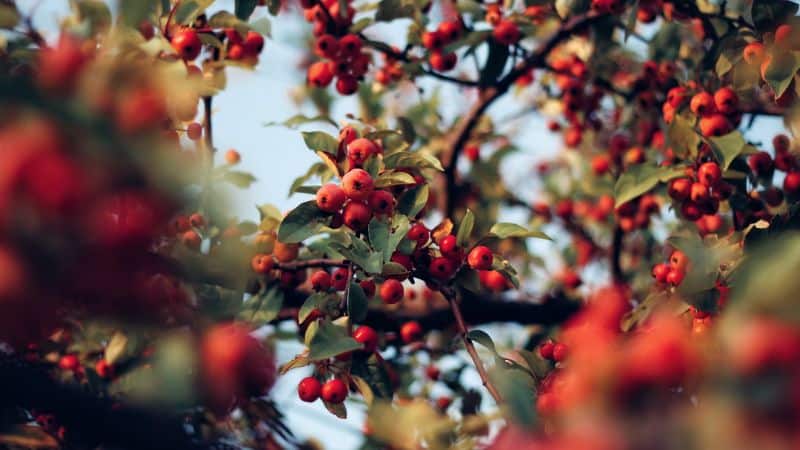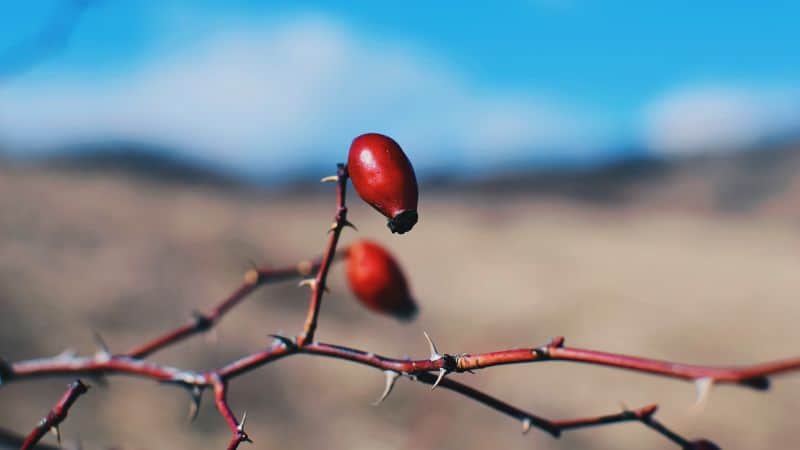Jump to:
Many roses provide a superb display of tomato-red or bright orange hips, which add an extra layer of fun to late summer and autumn gardens. Some provide better hips than others, so it’s worth doing some research to make sure you get the best kind.
In this article, we’ve listed everything you need to know about Rosehips, including the recommended varieties you can plant and growing tips. Let’s get into it!
Facts About Rosehips

Specialist rose books often call hips “heps”. The word originally came from the Middle English “hepe”. Dialect names for wild rose hips are more extravagant and include “hedge-pedgies”, “nippernails”, “pixie pears” and “pig’s noses”.
Hips are a rich source of vitamin C and can be taken as a syrup or eaten. Connoisseurs claim that the Rugosa hips have the best flavour and are the least fiddly to prepare. Each one must be top and tailed, then cut in half to remove the seeds and irritating hairs. Then they are stewed, dried or pounded into a paste for freezing.
Recommended Varieties

Roses for hips are grown in exactly the same way as other roses, but they’re often better suited to wild or cottage gardens where their vigorous growth gets plenty of room to spread.
Ramblers
Let them shoot up into old, stout trees forming a tangle of stems, or grow around pillars or pergolas where they can be kept much more shapely. They flower once a year.
- R. filipes ‘Kiftsgate’: a massive, stupendous rambler that has vicious thorns and makes a good keep-out barrier when grown around fences. The small hips follow the white flowers; it grows to about 9m (30ft). Has been awarded the Royal Horticultural Society’s Award of Garden Merit (AGM).
- R. soulieana: a dog rose with soft grey foliage and white flowers opening from creamy yellow buds. It makes a large shrub 3-4m (10-13ft) high, a thick impenetrable hedge, or you can train it as a climber on a pillar with late-flowering Clematis viticella, or C. orientalis, which produces fluffy seed-heads. Try to position it where the autumn sun can shine on its tiny, bright orange hips. Has been awarded the Royal Horticultural Society’s AGM.
Wild Roses and Hybrids
All are good contenders for borders and wild gardens, where they put on a good show of flowers once a year.
- R. ‘Geranium’: making a large bushy shape, overhead high, it has bright red flowers followed by enormous hips.
- R. roxburghii: an attractive pink burr rose with round green hips as hard and prickly as immature conkers.
- R. sweginzowii: bristly orange-berries on long spiny canes. It can be mingled with other shrubs in a wild garden. Rare but worth hunting out.
Shrubs
Usually growing about head high, they often repeat flower and the following also offer a good show of hips.
- R. rugosa ‘Alba’: with ‘Rubra’ and ‘Frau Dagmar Hastrup’, it bears fat, impressive, tomato-like fruits. The rugosas make large, dense, attractive, robust shrubs with lush leaves. Some continue flowering until quite late, while also fattening their magnificent hips from earlier blooms. ‘Alba’ and ‘Rubra’have been awarded the AGM.
Edible and Sweet
Fruiting varieties are usually edible and pleasantly sweet, especially if you wait until the first or second sharp frost has concentrated their sugars.
- R. ‘Buff Beauty’: a shoulder-high yellow-flowering shrub rose with a good scent. Also, try ‘Felicia’ and ‘Penelope’. All three have been awarded the AGM.
Growing Tips

Pruning
To get good rose hips, don’t deadhead or the plants can’t produce seeds. Also, prune only once, in late winter or early spring, to the desired shape or simply remove some of the oldest branches. Leaving well alone will pay the best dividends.
Propagation
To propagate, cut off the hips when they’re fully coloured but before they shrivel. Bury them in trays of moist compost outdoors in the cold. Frost is essential for germination, which is why a hard winter can result in a forest of seedlings around roses that are left unpruned. In late winter, sort out the hips and squeeze their contents into a bowl of water, where they’ll either float or sink. Only the seeds that sink are fertile and worth planting and should be sown in pots in a cold frame.
Problem solver
Most wild roses are problem-free. Otherwise, keep a lookout for black spot and spray accordingly. Let birds pick off any aphids.
Greenhouse
These can be grown in your own garden beds or in a greenhouse, with the latter option being better for those worried about cold temperature or poor weather.










